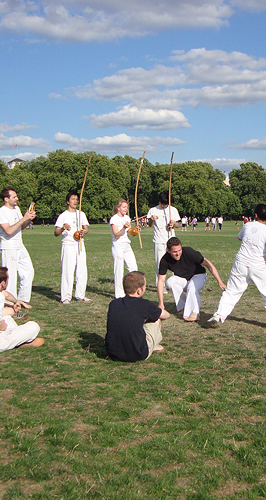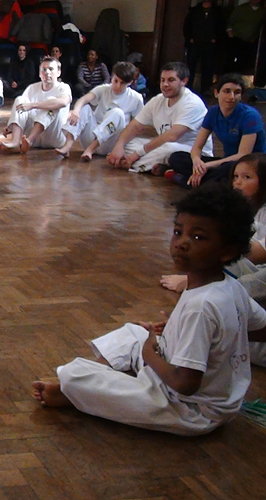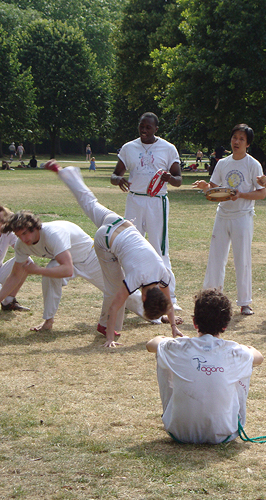formation of the roda
roda [Portuguese; pron: hoda] – wheel, circle
Roda in Capoeira, refers to a circle in which Capoeira game takes place. It can happen in a regular class or on special occasions.
Roda is formed by people sitting or standing in a roda. If live music is played, there are up to eight Capoeiristas playing instruments, sitting next to each other in a slightly curved line at the head of the circle, forming a bateria. During the roda, two people play a Capoeira game in the middle of that circle.
bateria
The bateria consists of up to eight instruments, with innermost berimbau (Gunga) leading the roda. The instruments and their placement in a roda can vary in various academies. In our academy, looking from left to right (if facing the musicians) the bateria is formed by two pandeiros, three berimbaus (Medio, Gunga, Viola – Medio and Viola can swap places, with Gunga always in the middle), reco-reco, agô-gô (those two instruments can swap places), and finally to the far right - atabaque.
instruments’ hierarchy
The most highly ranked Capoeirista usually plays the berimbau Gunga, dictating the rhythm of the music and the tempo. This person is the master of the roda and leads all aspects of the roda.
The instruments start playing in the roda in the following order – berimbaus: Gunga, Medio, Viola, pandeiros, reco-reco, agô-gô (or agô-gô, reco-reco) and atabaque. Atabaque doesn’t play from the start nor during the ladainha (opening song), it joins in together with the choir in reply to the first line of cantos de entrada.
When you play an instrument in a roda, you sit upright in a relaxed manner, with feet un-crossed and without resting your elbows on your legs.
pé do berimbau (pé da cruz)
Pé do berimbau (foot of the berimbau), also reffered to as pé da cruz (foot of the cross), is the main place in the roda, in the centre of bateria, in front of the berimbau which leads the roda.
sitting in the roda
How you sit in a roda, even if you don’t hold an instrument, is equally important. With your knees bent and arms around your knees, you pay attention to the game, answering the call together in a harmony as a choir (coro) and contribute to the roda with your energy and singing. At the end of each game you clap, cheering for the two players who have just played. (In some academies, especially in Capoeira Regional, you might see people sitting in a roda clapping during the games.)
Those who sit in a roda leave two empty spaces in places where they ‘meet’ with bateria. If somebody wants to play a game, they stand up and walk behind the people sitting in a roda until they reach one of those gaps and they squat, waiting for their turn to play. There is no walking behind the bateria. If you sit near one of the gaps and somebody else squats there, you walk behind everybody sitting in a roda, all the way round to the other spot, opposite your game partner.
People sitting in a roda, don’t talk nor leave the roda while it lasts and they maintain the shape of the roda.
opening game
The very first game (opening game), is played by the two oldest Capoeiristas in the roda (oldest in the meaning of their Capoeira experience), from amongst those who don’t play the instruments. Older Masters, teachers and Capoeiristas always have the priority in the roda.
As soon as the bateria starts playing, those two capoeiristas enter the roda through the two gaps between the people sitting in the roda and the bateria and squat at Pé do berimbau facing the instruments. From that moment the players should be aware of their opponent.
swapping the instruments
If you didn’t hold the instrument from the start of the roda, you should take initiative to play the instrument at some point during the roda. You can swap the instruments at any time during the roda but do it at an appropriate moment in between the games, in order not to interrupt the flow of the game and the energy.
When the moment arrives, pay attention to whether anybody else is swapping the instrument as only one instrument should be changed at a time. In other words, few instruments can be swapped between the same two games, however it is important to hold the rhythm. So if you see somebody else swapping the instrument, wait until they take over and get into the rhythm and then swap your instrument. The berimabu leading the roda will wait for the new musicians to pick up the rhythms, before commanding the two new players to commence their game.



